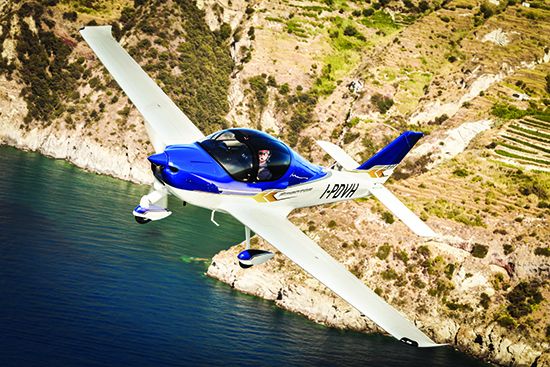Tecnam’s P-Mentor came onto the scene in April 2002 having already received its EASA CS-23 type certificate even before its official debut. The Italy-based company introduced it as a purpose-built trainer designed to cover pretty much the whole range of single-engine instruction—including instrument and upset prevention and recovery training (UPRT). FAA validation is reportedly around the corner, with Tecnam saying it is tentatively expected to come through around midsummer this year.
Since its introduction, the P-Mentor has been getting a fair bit of attention globally. I got a chance to check it out last May when I attended a celebration marking 75 years in aviation for the Pascale family, which founded both Partenavia and Tecnam. While in Capua, longtime Tecnam test pilot Massimo De Stefano put me in the left seat to put the little two-seater through the wringer.
THE BASICS
Based on the Tecnam P2002 LSA, the tricycle-gear, bubble-canopy P-Mentor is heavier than its LSA forebearer, with a maximum gross takeoff weight of 1587 pounds. The fuselage is a mix of glass fiber reinforced polymer (GFRP) and metal alloy. It also features a new wing design, which uses metal alloy for the spars and wing box and carbon fiber reinforced plastic for the leading edge. In addition to giving it some really nice flight characteristics, the new wing also allowed the aircraft to pass EASA CS-23 amendment requirements for low speed and stall characteristics without a ballistic recovery system (BRS). That said, a BRS is approved and available as an option on the aircraft.
The P-Mentor is powered by a four-stroke, fuel-injected 100- HP Rotax 912 iSC engine, which drives a two-blade composite MT propeller. I haven’t flown many Rotax-powered aircraft and that has clearly been an oversight on my part. It was quiet, smooth and felt well-suited to the airframe. In addition, it means the aircraft is capable of operating on both avgas and mogas.
SPECIFICATIONS
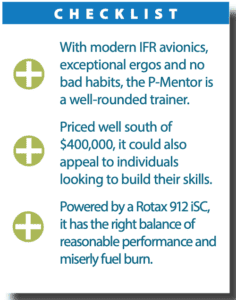
Keeping in the same range as most of the small trainer fleet, the P-Mentor offers a top cruise speed of 117 knots. However, if you want to get those cross-country requirements knocked out and aren’t in a particular hurry, it’ll take you a good way out with a 950-NM range. The model’s maximum endurance is around nine and a half hours, which will definitely pay off when it comes to refueling needs between lessons.
The P-Mentor has a useful load of 628 pounds, which leaves space for two good-sized pilots even with full fuel. The fuel capacity comes in at 34 gallons. Of note is that the fuel burn is about 14 L/H (3.7 GPH), making it an extremely efficient aircraft for the training environment.
With flaps down, the P-Mentor stalls at 44 knots, putting it again right around the norm for a two-seat trainer. By the book, it can take off in 1706 feet and land in 1280 feet. For the demo flight, we were on wet grass, so my actual experience was different, but it performed like I would expect.
COCKPIT/CABIN
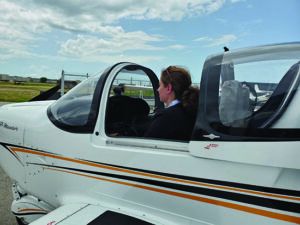
For me, the cabin was a comfortable fit. The caveat is that I’m 5 feet, 6 inches tall—I fit into most aircraft without too much of an issue. Even so, it felt roomy for a two-seater. There was good head clearance with the canopy shut and while it definitely wasn’t spacious, there was room enough for two of us without crowding. That said, it would likely be a tighter fit for two broad-shouldered individuals.
Getting in and out was reasonably easy for a low-wing aircraft. There’s a step by the leading edge of the wing, then onto the wing and into the cockpit. On the plus side, you can actually see the step on the way down and it’s close enough to both the wing and the ground that my short legs could reach without stretching.
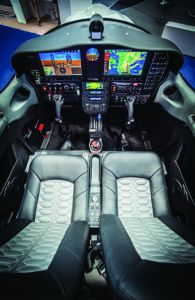
In case you haven’t yet identified the theme here, I’m not exactly tall. The other place this comes into play is seeing over the dash. Without a seat cushion, it can sometimes be a problem for me but I didn’t experience that in the P-Mentor. Especially with the canopy, which operated smoothly and latched easily, I felt like I had good visibility throughout the flight. As an extra bonus, the lack of visibility issues meant I got a great view of the Italian coast.
In terms of avionics, the P-Mentor comes equipped with two Garmin G3X Touch flight displays. In addition, it is outfitted with a Garmin GI 275 as a backup instrument and has an option to include the GFC 500 autopilot. An optional simulated retractable gear control (SRGC) is also available.
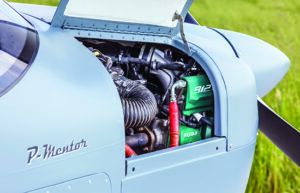
One thing that stood out for me was how intuitively the panel is laid out. Given that we were trying to avoid some approaching weather, I didn’t have a lot of time to familiarize myself with the layout before we were airborne. However, the panel design is such that when I went to reach for something, it was almost always in the first place I thought to look. Needless to say, that’s a helpful trait in any aircraft but a particular bonus in a trainer with new pilots who aren’t yet used to finding that really odd spot some engineer might have stuck the flap control.
I have to admit, I’m on the fence about the SRGC. On the one hand, I can see where it would be useful to practice for a retrac without actually needing to add one to the training fleet. On the other, I personally don’t care for having controls in an airplane that don’t perform the function they’re “supposed” to. That said, the SRGC did not interfere with any of the other controls or negatively impact the flight in any way. It’s a preference thing and an optional item to boot.
FLYING IT
The runway at Tecnam’s factory in Capua is currently a grass strip, although there are plans for it to be paved in the near future. The day we flew, it had been raining off and on for most of the week so conditions were somewhat less than ideal. I haven’t done much flying off of grass strips, but I was impressed with the way the P-Mentor handled wet grass and mud. We were off the runway in short order.
Other than the rain, conditions were good—about 70 degrees F and light winds. For lack of a better way to put it, the airplane climbs like a trainer. It’s not a high-performance model and isn’t pretending to be, but it got the job done and didn’t struggle in the slightest.
The aircraft does have Garmin’s electronic stability protection (ESP) as an added safety buffer, so we did stalls, steep turns and airwork with it both on and off. No surprises—again, making it worthy of the intended training environment.
Upon returning to the runway, landing went smoothly…OK, as smoothly as the mud and wet grass would allow. Taxiing was straight-forward: The aircraft has a steerable nosewheel and toe brakes.
Overall, the P-Mentor stalls cleanly and handled we’ll throughout the flight. Interestingly, when in the air it feels like a much bigger aircraft than it is without being clunky or unresponsive. There’s a combination of stability and responsiveness to it that not many of the two-seaters I’ve flown have managed to deliver.
MARKET, PRICE
The IFR version of the P-Mentor comes in at $350,750, making it a very attractive option compared to some of the competition. Adding the autopilot increases the price by $13,240 while including the BRS adds another $21,300.
As I’m writing this, orders for over 100 P-Mentors have already been placed in the U.S. and I can’t say I’m surprised. In addition to being fuel-efficient and less expensive than many other IFR-capable trainers, it handles beautifully and comes with all the bells and whistles one could want when learning to fly without having so many that it clutters up the learning process.
CONCLUSION
At the start of the flight, I was leaning in to being nostalgic about a brief return to my training days. However, the P-Mentor is so much more modern than the model I learned in that it was hard to compare them. It was also just fun to fly for itself. Nostalgia aside, it ended up being the kind of airplane I wanted to learn in.
Perhaps my big takeaway from the flight is that the P-Mentor is not an aircraft that will surprise you except in that it lacks surprises. While that may initially sound a bit boring, think about it: The best thing a trainer could possibly offer a student trying to learn is a predictable, safe and stable experience. And that’s exactly what the P-Mentor does with enough style added in to make you glad to be flying it.
Contributor Kate O’Connor is the Editor-in-Chief of sister publication AVweb.

